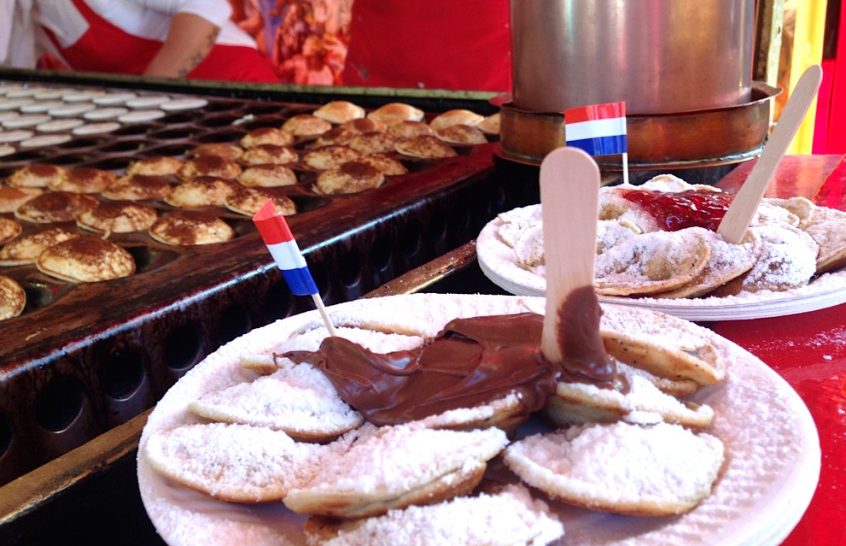13 Typical Dutch Foods
Italy and France are more commonly thought of as the “food epicentres” of Europe, and rightly so, they produce delicious food.
However, amongst the hype of the canals, windmills, clogs, tulips and red light districts, the food of The Netherlands can often get overlooked, which is sad. From mini pancakes to salty seafood, hail on bread and WHITE ASPARAGUS (say whaaattt?), this small country serves up many of its own delicious (although, not always nutritious) foods.
While I’m sure I’ve missed some, here are 13 typically Dutch foods you might not have heard of.
1. Stroopwaffels
Stroopwaffels (translation ‘syrup waffles’) are distinct from Belgian-style waffles. They consist of 2 thin waffles (like a waffle ice-cream cone before it’s rolled up) with a layer of syrup in between the waffles.
You can buy packets of small waffles in the supermarket (even in Australia). But the BEST are big ones, served warm and fresh on the market.

Arno and I (with a stroopwaffel)
2. Cheese (Kaas)
Edam, Gouda, Beemster and more. The Dutch take an enormous amount of pride in their cheese heritage with several towns continuing the 400 year old tradition of a weekly cheese market (I visited the Alkmaar cheese market, have a red here).

Alkmaar Cheese Market
Unlike the French soft cheeses, Dutch Cheeses are harder and come in 12kg wheels for ease of transport (rolling). Quality cheese has an even spread of holes (or ‘eyes) throughout. These eyes are naturally formed by the Lactic Acid Bacteria and a “blind” (with no eyes) cheese is considered very inferior.
3. Poffertjes
Tiny pikelets cooked in pans with small divots. Served traditionally with butter and icing sugar but more popular these days is Nutella or strawberries and cream.
4. Pannenkoeken

Pannenkoeken with their fillings, cooking in large pans.
Really big pancakes served as a whole pancake on a plate. The ‘toppings’ are cooked INTO the Pancake while it’s on the pan as apposed to being arranged on top or folded into it (as is done with crepes). There are restaurants, called a “Pannenkoekenhuis”, in just about every town in Holland that serve almost exclusively Pannenkoeken! The array of combinations you can chose from (or choose your own) is seemingly endless. A typical Dutch topping combination is Spek, apple and cheese, topped with syrup but I had one with spek, appel, white asparagus (see food number 7) and goats cheese.

5. Appeltaart
Without fail, every cafe or restaurant in Holland will have a homemade Appeltart (delicious apple pie) on the menu.

Appeltaart met slagroom
6. Friets met Frietsaus
Friets stalls are EVERYWHERE in Holland, serving a very limited menu of friets (and occasionally kroketen). The Dutch love their chips with frietsaus, comparable to mayonnaise but a little more vinegar-y.


7. Witte Asperges
The same species as Green Asparagus you would find elsewhere in the world, however in Holland the farmers do not allow the stems to see the sunlight (which in combination with the chlorophyl, would ordinarily turn the stems green). It’s an elaborate process of continually building up the dirt around the stems so they stay sheltered!

Traditional serving of Witte Asperges
In Holland you traditionally peel and boil the white asparagus and serve it with ham, boiled eggs and asparagus sauce (a kind of white sauce). But I got a little bit inventive:


Witte asperges with Superfood Falafels and then with roast eggplant and my lasagne filling.
8. Dropjes
Dutch Licorice. Very salty and great for a sore throat. I love them but they’re one of those things you either love or hate (eg. vegemite). DON’T try it with the expectation that it will taste like Darrel-Lea Licorice, you’ll be very disappointed.

9. Hagelslag
Literal translation “hail blow”, basically these are like sprinkles or “100’s and 1000’s”. They come in seemingly endless varieties. There’s the chocolate range (dark, milk, white and mixed) that comes in flakes, balls or sprinkles. There’s Vruchten hagel (‘fruit’) which are multi coloured, excessively sweet sprinkles. And there are the hard round versions in blue/white or pink/white that you give to parents when they have a baby.



Hagelslag are eaten traditionally on bread with butter (surprisingly, not on ice cream and cakes!).
10. Salted Herring
With so much water around them, it makes sense the Dutch love their seafood. Salted herring with onions and pickles are a staple on a Dutch market.


I have to say, it wasn’t really my thing (and I am someone who normally does like cured and raw fish), I preferred when the herring was grilled.
11. Smoked Eel and Smoked Mackerel
Eel is being phased out due to issues with sustainability but the Mackerel is delicious! I’d compare it to smoked (cooked) salmon in flavour but perhaps a little ‘meatier’. This smaller fish is often smoked and sold as the whole animal.

Smoked Eel with pickled vegetables

Smoked Mackerel
12. Hollandse Garnalen
Tiny, tiny prawns, cooked however you like. Don’t let their size food you, they are absolutely BURSTING with flavour!

Hollandse Garnalen Stir Fry I made (with Cauli Rice and veggies)
13. Indonesian “Rijsttafel”
The Dutch have had a presence in Indonesia since the 16th Century before officially implementing governmental control in the 1800’s. Many Dutch people worked and travelled in Indonesia over the centuries. In fact my mother and many of my relatives were born in Indonesia as the family was working there. Indonesia declared independence from The Netherlands in 1945.

You find Indonesian influences in interior design as well as food in The Netherlands and Indonesian restaurants are commonplace. For birthdays and other special occasions, it is not unusual for people to make, or go out for, an Indonesian “Rijsttafel” (translation, “Rice Table”). This is essentially an Indonesian banquet where anywhere from 12-20 dishes are prepared and served all at the same time on a large table, with rice, the family/diners sit around the table and eat what they like!
Well that’s all I have for you! I hope you will one day make it to The Netherlands and try some of its traditional foods!

